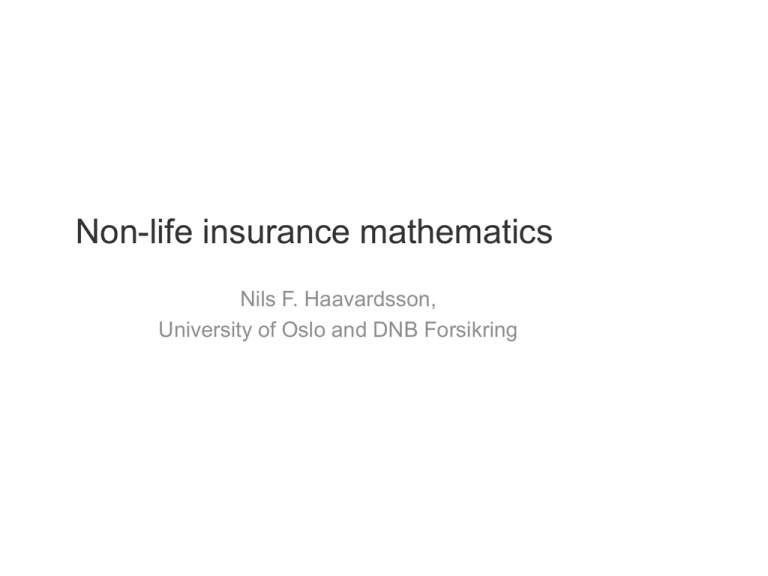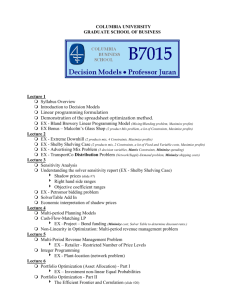lecture11solvency
advertisement

Non-life insurance mathematics
Nils F. Haavardsson,
University of Oslo and DNB Forsikring
Agenda
•
•
•
•
The motivation
The sources of risk
Portfolio liabilities by simple approximation
Portfolio liabilities by simulation
The main driver of financial regulation is to avoid
bankruptcies and systemic risk
Protecting policy holders across the EU
Optimizing capital allocation by aligning capital requirements to actual
risk
Create an equal and consistent regulatory regime across the EU
Create regulations that are consistent with the ones in comparable
industries (particularly banking)
Create an improved «platform» for proper regulation and supervision,
based on increased transparency, more data and better documentation
SCR
Standard model
Adj
Market
BSCR
Health
Interest
rate
SLT
Health
Equity
Mortality
H CAT
Default
Non-SLT
Health
Premium
Reserve
16
Longevity
Property
43
Spread
Disability
Morbidity
Currency
Lapse
Concentration
Lapse
Op
Life
Non-life
Mortality
Premium
Reserve
Longevity
Lapse
Disability
Morbidity
NL CAT
Intang
Lapse
Expenses
Nat Cat
Revision
NP Reins.
Mass
accident
30
Expenses
Accident
conc.
Revision
L CAT
Man made
Pandemic
NL CAT
other
https://eiopa.europa.eu/Publications/Standards/A__Technical_Specification_for_the_Preparatory_Phase__Part_I_.pdf
Solvency
• Financial control of liabilities under nearly
worst-case scenarios
• Target: the reserve
– which is the upper percentile of the portfolio
liability
• Modelling has been covered (Risk premium
calculations)
• The issue now is computation
– Monte Carlo is the general tool
– Some problems can be handled by simpler,
Gaussian approximations
10.2 Portfolio liabilities by simple
approximation
•The portfolio loss for independent risks become Gaussian as J tends to infinity.
•Assume that policy risks X1,…,XJ are stochastically independent
•Mean and variance for the portfolio total are then
E ( ) 1 ... J and var( ) 1 ... J
and j E ( X j ) and j sd ( X j ). Introduce
1
1
2
( 1 ... J ) and ( 1 ... J )
J
J
which is average expectation and variance. Then
d
1 J
2
X
N
(
,
)
i
J i 1
as J tends to infinfity
•Note that risk is underestimated for small portfolios and in
branches with large claims
Normal approximations
Let be claim intensity and z and z mean and standard deviation
of the individual losses. If they are the same for all policy holders,
the mean and standard deviation of Χ over a period of length T
become
E(Χ ) a0 J , sd(Χ ) a1 J
where
a0 T z and a1 T z2 z2
Poisson
Some notions
The rule of double variance
Examples
Random intensities
Let X and Y be arbitrary random variables for which
( x) E (Y | x)
and
2 var(Y | x)
Then we have the important identities
E (Y ) E{ ( X )}
Rule of double expectation
and
var(Y ) E{ 2 ( X )} var{ ( X )}
Rule of double variance
8
Poisson
Some notions
The rule of double variance
Examples
Random intensities
Portfolio risk in general insurance
Z1 Z 2 ... Z where , Z1 , Z 2 ,... are stochastic ally independen t.
Let E ( Z1 ) Z where var( | ) Z2
Elementary rules for random sums imply
E ( | N ) N z and var( | N ) N z2
Let Y
and
x in the formulas on the previous slide
var( ) var{ E ( | N )} E{sd ( | N )}2
var( z ) E ( z2 )
z2 var( ) z2 E ( )
JT ( z2 z2 )
9
Poisson
Some notions
The rule of double variance
Examples
Random intensities
This leads to the true percentile qepsilon being approximated by
qNO a0 J a1 J
Where phi epsilon is the upper epsilon percentile of the standard normal distribution
and
a0 T z and a1 T z2 z2
10
Fire data from DNB
0.10
0.05
0.00
Density
0.15
0.20
0.25
density.default(x = log(nyz))
0
5
10
N = 1751 Bandwidth = 0.3166
15
Normal approximations in R
z=scan("C:/Users/wenche_adm/Desktop/Nils/uio/Exercises/Branntest.txt");
# removes negatives
nyz=ifelse(z>1,z,1.001);
mu=0.0065;
T=1;
ksiZ=mean(nyz);
sigmaZ=sd(nyz);
a0 = mu*T*ksiZ;
a1 = sqrt(mu*T)*sqrt(sigmaZ^2+ksiZ^2);
J=5000;
qepsNO95=a0*J+a1*qnorm(.95)*sqrt(J);
qepsNO99=a0*J+a1*qnorm(.99)*sqrt(J);
qepsNO9997=a0*J+a1*qnorm(.9997)*sqrt(J);
c(qepsNO95,qepsNO99,qepsNO9997);
The normal power approximation
ny3hat = 0;
n=length(nyz);
for (i in 1:n)
{
ny3hat = ny3hat + (nyz[i]-mean(nyz))**3
}
ny3hat = ny3hat/n;
LargeKsihat=ny3hat/(sigmaZ**3);
a2 = (LargeKsihat*sigmaZ**3+3*ksiZ*sigmaZ**2+ksiZ**3)/(sigmaZ^2+ksiZ^2);
qepsNP95=a0*J+a1*qnorm(.95)*sqrt(J)+a2*(qnorm(.95)**2-1)/6;
qepsNP99=a0*J+a1*qnorm(.99)*sqrt(J)+a2*(qnorm(.99)**2-1)/6;
qepsNP9997=a0*J+a1*qnorm(.9997)*sqrt(J)+a2*(qnorm(.9997)**2-1)/6;
c(qepsNP95,qepsNP99,qepsNP9997);
Percentile
Normal
approximations
Normal power
approximations
95 %
99 %
99.97%
19 025 039 22 962 238 29 347 696
20 408 130 26 540 012 38 086 350
Portfolio liabilities by simulation
• Monte Carlo simulation
• Advantages
– More general (no restriction on use)
– More versatile (easy to adapt to changing
circumstances)
– Better suited for longer time horizons
• Disadvantages
– Slow computationally?
– Depending on claim size distribution?
An algorithm for liabilities
simulation
•Assume claim intensities
for J policies are stored on file
1 ,..., J
•Assume J different claim size distributions and payment functions
H1(z),…,HJ(z) are stored
•The program can be organised as follows
•Assume log normal distribution for claim size
0 for (i in 1 : Number_of_ simulation s)
1 {
2 Number_of_e vents - rpois(1, number_of_ events_per _year)
3 Z_per_event - rlnorm(Num ber_of_eve nts, theta, sigma)
4 simulations [i] - sum(Z_per_ event)
5 }
An algorithm for liabilities
simulation using mixed distribution
•Assume p is given, representing the likelihood of being in the extreme right tail
•With likelihood 1-p non-parametric sampling from the data in the normal range is used
•With likelihood p sampling from a distribution selected for the extreme right tail is used.
•The program can be organised as follows
•Assume Weibull distribution for claim size in the extreme right tail
0
1
2
3
4
5
6
7
8
Not_extreme _Z - z[z Extreme_pe rcentile]
for (i in 1 : Number_of_ simulation s)
{
Number_of_n ormal_even ts - rpois(1, number_of_ normal_eve nts_per_ye ar)
Z_per_ normal_eve nt - sample(Not _extreme_Z , Number_of_ normal_eve nts, replace T)
Number_of_ extreme_ev ents - rpois(1, number_of_ extreme_ev ents_per_y ear)
Z_per_ extreme_ev ent - rweibull(N umber_of_e xtreme_eve nts, aphahat, betahat)
simulations [i] - sum(Z_per_ normal_eve nt) sum(Z_per_ extreme_ev ent)
}
Experiments in R
1. Find the claim size distribution
1a. Try Gamma
1b. Weibull
2. Simulate portfolio liability using Monte Carlo
3. Simulate portfolio liability using normal approximation
4. Compare the results
18
An algorithm for liabilities
simulation
•Assume claim intensities
for J policies are stored on file
1 ,..., J
•Assume J different claim size distributions and payment functions
H1(z),…,HJ(z) are stored
•The program can be organised as follows (Algorithm 10.1)
0 Input : j jT ( j 1,.., J ), claim size models, H1 ( z ),..., H J ( z )
1 * 0
2 For j 1,..., J do
3
Draw U* ~ Uniform and S * log( U* )
4
Repeat whi le S * j
5
Draw claim size Z *
6
* * H j ( z )
7
Draw U * ~ Uniform and S * S * log( U* )
8
Return *
Monte Carlo theory
Suppose X1, X2,… are independent and exponentially distributed with mean 1.
It can then be proved
Pr( X 1 ... X n X 1 ... X n 1 )
n
n!
e
(1)
for all n >= 0 and all lambda > 0.
•From (1) we see that the exponential distribution is the distribution that
describes time between events in a Poisson process.
•In Section 9.3 we learnt that the distribution of X1+…+Xn is gamma
distributed with mean n and shape n
•The Poisson process is a process in which events occur continuously and
independently at a constant average rate
•The Poisson probabilities on the right define the density function
Pr( N n)
n
n!
e , n 0,1,2,...
which is the central model for claim numbers in property insurance.
Mean and standard deviation are E(N)=lambda and sd(N)=sqrt(lambda)
An algorithm for liabilities
simulation
•Assume claim intensities
for J policies are stored on file
1 ,..., J
•Assume J different claim size distributions and payment functions
H1(z),…,HJ(z) are stored
•The program can be organised as follows (Algorithm 10.1)
0 Input : j jT ( j 1,.., J ), claim size models, H1 ( z ),..., H J ( z )
1 * 0
2 For j 1,..., J do
3
Draw U* ~ Uniform and S * log( U* )
4
Repeat whi le S * j
5
Draw claim size Z *
6
* * H j ( z )
7
Draw U * ~ Uniform and S * S * log( U* )
8
Return *







